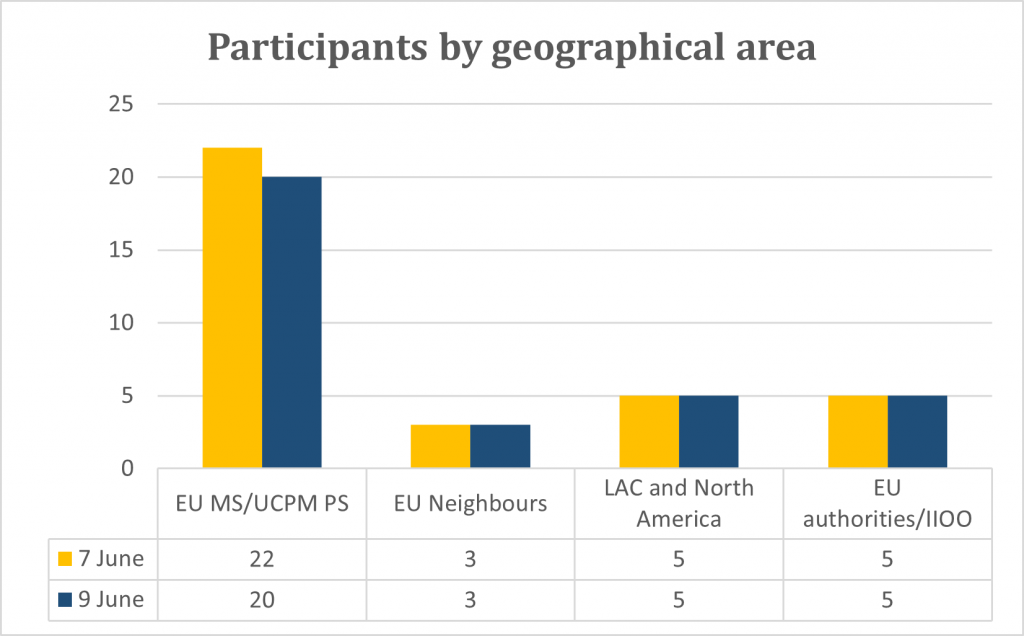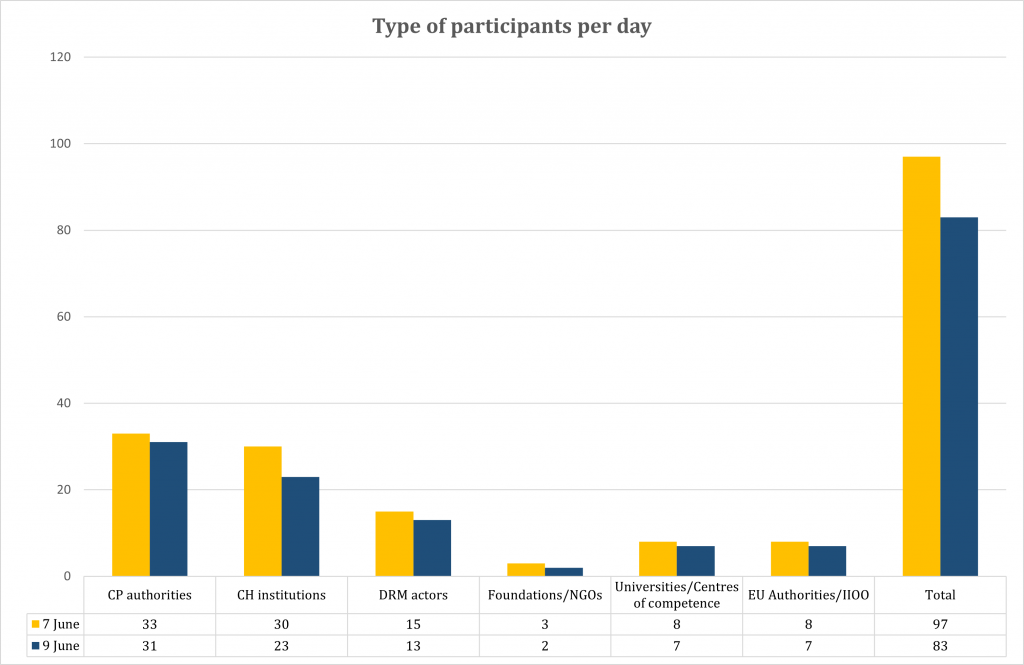Proculther takes further steps towards a common European approach and methodology for the protection of cultural heritage at risk of disaster
By Simone Sbarsi
The PROCULTHER International Workshop “Defining European Technical and Operational Capacities for the Protection of Cultural Heritage at Risk of Disaster” held in virtual mode on 7 and 9 June 2021 has been an important opportunity to share views and debate key elements to strengthen the protection of cultural heritage at risk of disaster at European and international level. The impressive and widespread geographical participation of experts from both the disaster risk and cultural heritage management fields, as well as their enthusiastic interest and proactivity during the sessions dedicated to the debate, are a clear signal of the pressing need to ensure a common approach for the inclusion of the protection of cultural heritage at risk of disaster in disaster risk management processes.
Being an initiative within the framework of the European Union Civil Protection Mechanism (UCPM), this event is part of the activities intended to sustain and complement the efforts made by the European Union (EU) in strengthening cooperation between EU Members and the 6 Participating States (Iceland, Norway, Serbia, North Macedonia, Montenegro, and Turkey) to develop and improve technical and operational capacities for the safeguard of cultural heritage at risk of disaster at local, national and European level.

(EU MS= European Union Member States/ UCPM PS = Union Civil Protection Mechanism Participating States/ LAC = Latin America and the Caribbean/ IIOO= International Organisations)
Although the workshop was particularly addressed to the UCPM Participating States (PS), it succeeded in offering a space to all Countries – including non-European -, International Organisations and actors wishing to contribute to the revision of the “Key Elements of a European Methodology to Address the Protection of Cultural Heritage during Emergencies” proposed by PROCULTHER. The event in fact managed to bring together a wealth of inter-disciplinary expertise at national and international level with nearly 100 participants on the first day and about 80 on the second, counting experts from more than 30 countries (including 18 EU Member States and 4 UCPM Participating States, as well as from Argentina, the Caribbean region, Costa Rica, Israel, Mexico, Palestine, the United Kingdom and the United States), and 16 speakers from civil protection authorities, ministries, governmental and research institutions as well as from the European Commission Directorates DG ECHO, DG EAC and from international organisations active in both disaster risk management (DRM) and cultural heritage protection, such as UNESCO, UNDRR and ICCROM.

The first day, 7 June 2021, opened with the welcome and opening speeches by high representatives of the PROCULTHER Consortium: Fabrizio Curcio, from the Italian Civil Protection Department, followed by Marica Mercalli, from the Italian Ministry of Culture, Gumersindo Bueno Benito, from the Junta de Castilla y León (Spain), Frédéric Clowez, from the French Direction Générale de la Sécurité Civile et Gestion de Crise, Hamza Taşdelen, from the Turkish Ministry of Interior-Disaster and Emergency Management Presidency, and Fabrizio Boldrini, from the Fondazione Centro Studi Villa Montesca, Italy.
Then two valuable interventions followed proving the high level of attention that the European Commission is paying to the safeguard of cultural heritage: Ms Leonor Nieto Leon, representing the EC/Directorate-General for European Civil Protection and Humanitarian Aid Operations (DG ECHO), Co-Funder of the project, confirmed the efforts exerted by the EU in this field, namely for promoting the establishment of a UCPM-driven module able to protect CH at risk of disaster. In addition, Anne Grady, Senior Cultural Heritage Expert within the EC/Directorate General for Education and Culture (DG EAC), provided an excursus on the policies and strategies undertaken to build up cultural heritage resilience for climate change and, in particular, illustrated the objectives set up by the Open Method of Coordination – OMC Working Groups composed of experts in the field of culture and nominated by EU Member-States to identify and exchange good practices and innovative measures for the protection of cultural heritage, and how these can mitigate the impact of climate change in line with the European Green Deal goals.
To complete this international perspective, Costanza Fidelbo, from the UNESCO Regional Bureau for Science and Culture in Europe – who also participates in the PROCULTHER Consortium-, presented the policies, actors, and resources for culture in emergencies made available by UNESCO. Finally, Giovanni De Siervo, PROCULTHER Director, concluded the introductory framework with an explanation of the project objectives and expected results.
The objective of the first day being that of capitalising on existing experiences to build shared European tools to protect cultural heritage at risk of disaster, the audience was readily introduced to the first day core topic: the presentation of best practices and lessons learnt in this sector. Thanks to a questionnaire drawn up by the PROCULTHER team to collect all relevant contributions, the project has been able to identify twenty practices: half of them came from UCPM States, the others from EU Neighbours, Latin American and Caribbean regions, as well as from North America, international organisations, and NGOs all offering interesting insights to integrate the framework of the methodology proposed by the project.
The first of the two sessions dedicated to the presentation of relevant case studies and good practices was moderated by Erminia Sciacchitano, from the Italian Ministry of Cultural Heritage. In this session, lessons learnt came from the Croatian Civil Protection Directorate, the emergency mechanism for cultural heritage in crisis situations set up by the German Archaeological Institute (DAI) with the Federal Agency for Technical Relief (THW) within the KulturGutRetter (KGR) project, and the Disaster Resilience Scorecard developed by UNDRR to monitor the implementation of the Sendai Framework for Disaster Risk Reduction by local communities. Two EU Neighbours, Israel and Palestine, Consortium Partners of PROMEDHE – the PROCULTHER project precursor – contributed to enrich the discussion by sharing their experience and the PROMEDHE long term results. The second session was moderated by Gumersindo Bueno Benito, from the General Directorate for Cultural Heritage of the Junta de Castilla y León (Spain), who then gave the floor to academics and institutions mainly belonging to the cultural heritage world: the University of Porto (Portugal), the National Institute of Anthropology and History in Mexico, the Smithsonian Institution in United States, the Ministry of Culture in Argentina and the Historic Environment of Scotland.
For an overview of the case studies presented on 7 June, interested readers can refer to the Book of Abstracts, and/or watch the videos of the event broadcasted live on the PROCULTHER Channel (links to the videos available below), while for the outcomes of the event is available the International Workshop Executive Summary.
On June 9th , the event got into full swing, and after a brief overview given by Giovanni De Siervo on the objectives of the second day, Veronica Piacentini, expert in cultural heritage disaster management from the Italian Civil Protection Department working on PROCULTHER, introduced the main contents of the seven chapters of the document “Key Elements of a European Methodology to Address the Protection of Cultural Heritage during Emergencies”, namely dealing with key elements for the definition of: an institutional framework focused on the protection of cultural heritage at risk of disaster, measures for the inclusion of cultural heritage in the DRM cycle, a coordination structure, teams, tools/formats for an effective data collection and management on cultural heritage at risk, as well as training and exercises.
Then Aparna Tandon, senior expert from ICCROM, skilfully animated the participatory session foreseen for the exchange of feedbacks and opinions on the main topics and technical contents that PROCULTHER is proposing at European level. Some 60 experts from 28 countries, International Organisations and from the European Commission were invited to discuss and exchange points of view through six consecutive tables of discussion.
Following this open debate, the experts were called to answer 13 questions on the same topics and the survey demonstrated that the project is undertaking the right path towards a common European approach and methodology for the protection of cultural heritage at risk of disaster, as the opinions collected show a general consensus on the document elaborated by PROCULTHER.
Among the precious opinions, it is worth mentioning a wide agreement reached on the following issues: formal agreements are needed, especially at international level, to implement common strategies and procedures; it is of outmost importance to include cultural heritage in the DRM cycle and, consequently, to define roles, responsibilities, and competencies to achieve an effective coordination among the actors involved. In addition, during post disaster phases, shared templates shall support cultural heritage teams involved in the assessments on immovable, movable and intangible cultural heritage with the purpose of enhancing recovery planning and ensuring effective interventions. Furthermore, a strong agreement was reached on the need to establish a “Safeguarding Cultural heritage Cell” in each national/regional system to ensure effective and coordinated DRM operations, and to foresee training courses for cultural heritage experts and DRM actors to define common language and procedures, comprehensible to everyone and tested during tailor-made exercises.
In conclusion, this International Workshop has represented the first chance for PROCULTHER to share the structure and approach of the “Key Elements of a European Methodology to Address the Protection of Cultural Heritage during Emergencies” that will be completed in the forthcoming period with the considerations made during the event by all participating countries and actors.
